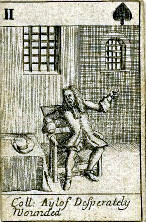Related Research Articles

The Rye House Plot of 1683 was a plan to assassinate King Charles II of England and his brother James, Duke of York. The royal party went from Westminster to Newmarket to see horse races and were expected to make the return journey on 1 April 1683, but because there was a major fire in Newmarket on 22 March, the races were cancelled, and the King and the Duke returned to London early. As a result, the planned attack never took place.

Richard Rumbold (1622–1685) was a Parliamentarian soldier and political radical, exiled for his role in the 1683 Rye House Plot and later executed for taking part in the 1685 Argyll's Rising.
Sir Salathiel Lovell (1631/2–1713) was an English judge, Recorder of London, an ancient and bencher of Gray's Inn, and a Baron of the Exchequer.
Sir Thomas Exton (1631–1688) was an English admiralty lawyer, Member of Parliament, and Master of Trinity Hall, Cambridge.
Stephen Lobb was an English nonconformist minister and controversialist. He was prominent in the 1680s as a court representative of the Independents to James II, and in the 1690s in polemics between the Presbyterian and Independent groups of nonconformists. His church in Fetter Lane, London is supposed to be the successor to the congregation of Thomas Goodwin; he was the successor to Thankful Owen as pastor, and preached in tandem with Thomas Goodwin the younger.

William Jenkyn (1613–1685) was an English clergyman, imprisoned during the Interregnum for his part in the 'Presbyterian plot' of Christopher Love, ejected minister in 1662, and imprisoned at the end of his life for nonconformity.
William Howard, 3rd Baron Howard of Escrick was an English Parliamentarian soldier, nobleman, and plotter.
Henry Cornish was a London alderman, executed in the reign of James II of England.
Sir William Jones was an English lawyer and politician.
Sir Richard Lloyd (1634–1686) was an English jurist and politician. He was Admiralty Advocate from 1674 to 1686, and appointed Judge of the High Court of Admiralty from 1685 to 1686.
Bruno Ryves (1596–1677) was an English royalist churchman, editor in 1643 of the Oxford newsbook Mercurius Rusticus, and later dean of Chichester and dean of Windsor. Both Ryves's Christian name and surname were variously spelled by his contemporaries: Brune, Bruen, Brian, Bruno; and Reeves, Rives, Ryve, Reeve, and Ryves.

John Ayloffe was an English lawyer, political activist, and satirist, described as "one of the most consistently committed radicals of the century". According to his contemporary and political opponent Sir Roger L'Estrange, there were few 'more daring men for a desperate exploit'.
George Slade Butler (1821–1882) was an English lawyer and antiquary.
Nathaniel Wade was an English lawyer and conspirator implicated in the Rye House Plot and participant in the Monmouth Rebellion.

The Scottish Renaissance humanist George Buchanan gave a long list of Scottish Kings in his history of Scotland—published in Latin as Rerum Scoticarum Historia in 1582—most of whom are now considered by historians to be figures of legend, or completely misrepresented. The list went back around 1900 years from his time, and began with Fergus I. James VI of Scotland, who was Buchanan's pupil, adopted the story of Fergus I as his ancestor, and the antiquity of the line was emphasised by the House of Stuart.
Edward Forster the elder (1730–1812) was an English banker and antiquary.

Sir William Dalison was an English judge who served as a Member of Parliament for Lincolnshire in 1553.
Aaron Smith was an English lawyer, involved in the Popish Plot and Rye House Plot.
Edward Bridgeman was an English politician who sat in the House of Commons between 1625 and 1629.

Richard Kingston was an English political pamphleteer, clerical impostor, and spy.
References
- . Dictionary of National Biography . London: Smith, Elder & Co. 1885–1900.
- Attribution
![]() This article incorporates text from a publication now in the public domain : "Nelthorpe, Richard". Dictionary of National Biography . London: Smith, Elder & Co. 1885–1900.
This article incorporates text from a publication now in the public domain : "Nelthorpe, Richard". Dictionary of National Biography . London: Smith, Elder & Co. 1885–1900.